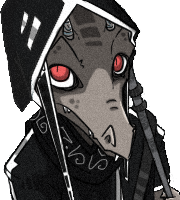|
Night10194 posted:Given what actually high grade dwarfen beer can do, I'd be terrified of what they'd call rotgut. I presume it is a hypergolic oxidizing alcohol typically used by dwarfs for etching metal and getting rid of those extremely stubborn memories/brain cells.
|
|
|
|

|
| # ? Apr 18, 2024 04:41 |
|
OvermanXAN posted:What's that from? It looks distinctly like Skaven.jpg. (Not enough Warpstone I guess) Pyre, I think?
|
|
|
|
Night10194 posted:To be fair Gilbert's charge across the lava bridge at some confused, extremely inattentive Skaven was a direct call to Lancelot's approach to stab the poo poo out of a wedding. It was appreciated.
|
|
|
|
Leraika posted:Pyre, I think? Not Supergiantís Pyre, at least.
|
|
|
|
Leraika posted:Pyre, I think? I think it's A Ghost of a Tale.
|
|
|
|
Loxbourne posted:Just do a stint in the Catrazzan Birdmen, it's right there as a second-tier career. Entries are Engineer, Mercenary, Targeteer, and Watchman. Hmmm. Targeteer is one of the Elf girl's eventual careers. I was planning to take the Skald in a more maritime direction, going into Reaver, then Whaler but I could go more toward Mercenary. The Dwarf was supposed to go toward Runesmithing, but Engineering is also possible. I wonder If I could get the whole group into that career at the same time so we could get the WHFRPG version of: https://www.youtube.com/watch?v=hn37QfXw1-E&feature=emb_title I am planning to put a Tilean in the group just for the "I told you so multiple times" bit when they run into Skaven. Everyone fucked around with this message at 02:09 on May 27, 2020 |
|
|
|
 Chapter 3: Character Creation And now, after I promised to run you guys through character creation, I realize I donít have the core book and only know the storyteller system in abstract. Instead of sinking however much money I donít have into buying the book, Iíll fake it with my general knowledge, the character sheet in the back, and the fact that Autochthonia is pretty self-contained mechanically. Itís not like Iím ever going to use this character, and Iím sure the thread can tell me where (not if) I go wrong. The chapter intro comic focuses on a pair of Sodality technicians putting the finishing touches on an Alchemical. In between detailed shots of all the machinery, one vaguely mentions his Alchemical fetish and says they always look like women to him before they wake up while the other takes potshots at him. The final panel features the Alchemical waking up: she is, in fact, a woman. 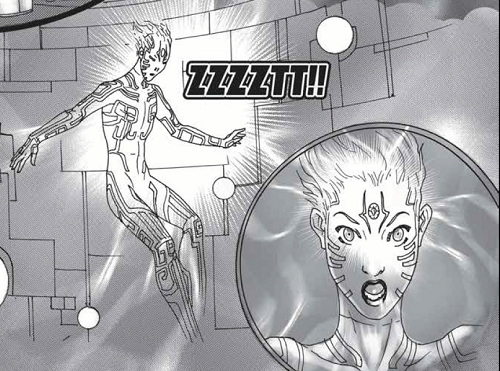 Alchemicals, by design, stand apart from Autochthonian society even as they embody it. In a society where survival rests on obedience, efficiency, and thoroughness, they innovate, experiment, and challenge those around them. On the other hand, they spend most of their time defending the status quo in countless ways at the behest of the Tripartite. This contrast, the tension between freedom and duty, defines the Alchemical experience. But whether they favor protecting the community, embracing personal freedom, or trying to strike a balance between the two, their actions are as overwhelming and world-shaking as of those of any other kind of Exalted. When you make a character, the book advises you to emphasize that last fact, not the strangeness of the world around them, while coming up with a basic concept. However, once youíve chosen an archetype you should tie it into the setting in an appropriate way; if you want to be a monster hunter, make yourself a gremlin hunter, say. Their name should reflect their concept and their personality; he book describes Alchemical names as ďhalf personality summary and half military weapon designationĒ in a sidebar that includes the names of several currently prominent Alchemicals as examplĖ 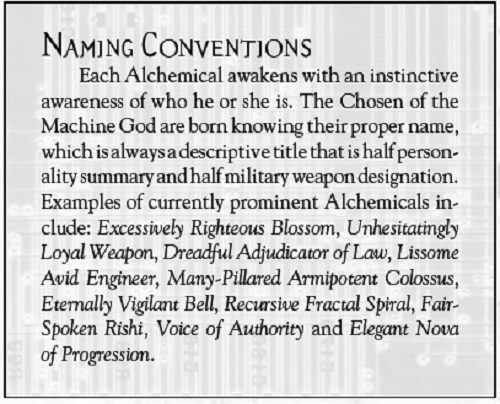 Wait, is thatÖ  No, wait, it canít be Ė 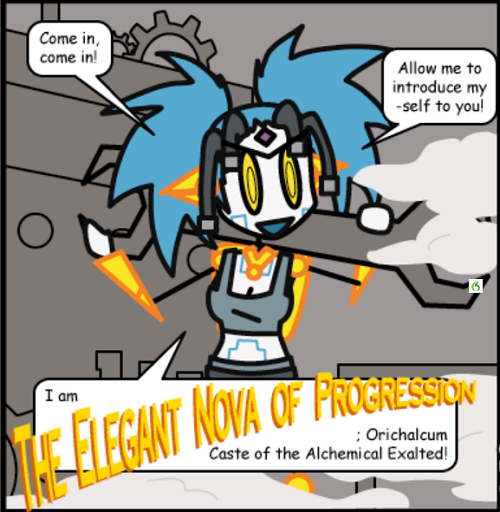  I mentioned in the first post the bulk of my exposure to Exalted came from some fan stuff. Keychain of Creation is that fan stuff. That webcomic is a landmark of Exalted fandom online, detailing the physical and personal journeys of several Exalted through huge chunks of Creation. Iíve loved it for years. Elegant Nova of Progression shows up part way through as an Alchemical who fell through some hole into Creation and set up her own successful microstate, and she makes for a compelling half-amusing, half-threatening antagonist. The devs seem to have confirmed her presence in the book as a deliberate reference to the comic; apparently more than one were already fans. Unfortunately the comic has been been discontinued: the author seems to have developed severe tendinitis and dropped off the face of the Internet, his last confirmed sighting being maybe half a decade ago. No one knows what happened to him. Anyway, Alchemicals emerge from the vats with fully formed adult personalities. Thatís not to say they didnít have childhoods, though; in fact, they had several (and I just realized this is an echo of Autochthonís multiple-souled nature, good job devs). Their personalities are composites of half-remembered past lives assembled into a coherent piece at the end of the Expectation process without them bothering with any identity confusion or dysphoria. These lives serve as character hooks, both providing players with ways to get a handle on their character and giving GMs the opportunity to reveal details about them at suitably dramatic intervals. Both of these angles offer ways to explain gaining new skills too. Next up is their caste, determined by the dominant magical material in their construction, which has a greater effect on their capabilities then Exaltations do in Creation. Instead of the mental-physical-social attributes choice you get in most White Wolf games, a characterís caste provides them with a set of three attributes (one from each category) to treat like their primary category; you then choose three other attributes as favored attributes and let the rest sit at the bottom of the heap, assigning dots to them like you would to categories in vanilla. And then you add a dot to an attribute in the first or second tiers because youíve earned it. Next up are abilities, which work like in the base book, and Backgrounds and Charms, which have their own chapters and quirks so Iíll cover them later. After that you determine their Virtues (the same as in Creation) their Intimacies (same as in Creation, but since emotional bonds interface with Clarity, the book recommends you record the emotional context behind each one), and their Essence, Willpower, and Health. Work in your bonus points, double check and fluff out the result, and youíre done. 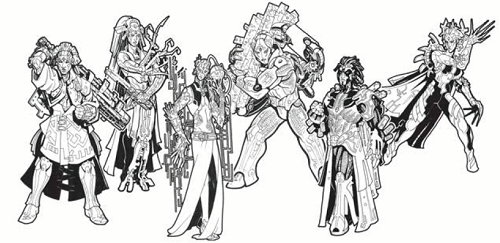 Exemplar of Unfailing Rhythm remembers many prior lives, the same as every Alchemical, but the bulk of her personality draws from three. The most recent, a Yugashi Populat sanitation worker named Richa, was demoted to Lumpen after being falsely accused by an experienced Colossus of hoarding. Accepting his fate with stoic determination, he dedicated himself to caring for his stirring-stick, the only possession he was allowed to keep, before his isolation got to him; he started believing it carried an animating intelligence that wanted him to use it as a weapon. For years Richa obsessively practiced in secret in an abandoned tunnel deep within the metropolis, developing forms and techniques on his own, until a Clamaki raiding party encountered him while trying to infiltrate it from beneath. When he arrived to investigate the sounds of combat, that same Colossus found Richa taking down the last of over two dozen trained soldiers, still fighting despite the severity of his wounds. Richa never fully recovered from his fight, but the Colossus cleared his record and ordered his status restored. By the time he died four years later the two had become very close and Richaís staff-based Redemptive Sanitation Style had been incorporated into Yugashís training regimen. The former Colossusís sanitation district now carries his name. Rhythm derives her dedication, empathy with the Populat and Lumpen, and selflessness from him. The second personality, an Orichalcum caste named Uplifting Touch of Chrome, lived over 2000 years ago in Nurad, back when it was still a functioning society. The rare Alchemical to lack a gender identity, Chrome dedicated themself to raising morale in their city, eventually developing an obsession with two things: music and sex. They proved themselves capable with both, too, and productivity rose wherever they spent their time. Unfortunately they had a habit of flouting authority well beyond what was acceptable even for an Alchemical, and if they hadnít died rescuing members of their nascent cult from a factory collapse they may have gone too far. Rhythm borrows their love of life, desire to help others, and fascination with music (but not so much sex). But her fascination with music goes deeper. She thinks that last life was at least as far away from Chrome as she is from them. She doesnít know their name, gender, or nation, nor much about their personality. She thinks they were one of the first Alchemicals and that they were only a few generations removed from Creation, though either of those facts might be wrong. All she has is a mixture of brief, indistinct impressions and memories of Chrome remembering them, except for one thing. They were the last Autochthonian to remember a musical technique from Creation, one lost in the chaos of Autochthoniaís early days. The force of that memory has pierced through the fog to form the foundation of her worldview (if asked about it, sheíll ruefully admit itís probably more important to her than it was to them). She has more on her mind than just music and doesnít dwell on it much, but her goal remains clear: she wishes to bring syncopation back to the peoples of Autochthonia.  Rhythm is a Jarishian Jade caste standing at around 5í8íí and almost half as wide; she has the broad, muscular build of an idealized Populat laborer and can certainly fill the part. She wears a mixture of factory-issue protective gear and the bright clothing of a Lector, and she tends to shout and emotes with her hands when she talks. When not working with her assembly, she spends her time composing and singing her compositions on the patropolisís PA/radio system, chatting up members of the Theomachracy (including her on-again off-again Lector boyfriend), and trying to re-create Redemptive Sanitation style from memory with the aid of the local military. Friendly and accommodating by nature, she can suddenly and dramatically lock down if she feels sheís being pushed too far, and when she focuses on something, she will ignore everything beyond her objective until someone snaps out her out of it. Rhythm sees the world as just that: a river of repeating patterns, some beautiful and some dissonant, that combined to make a massive, complex harmony. Though it comforts her in some respects, her worldview doesnít tell her what notes she should be playing, and she is prone to freezing up if her efforts backfire. This leads to tension with her assembly, who see her as noncommittal and hesitant. Right now sheís dealing with the attention of the local Celebrant, a deeply conservative woman with serious musical chops of her own; sheís the sort of person who can play something passť so well it moves people whoíve heard the piece a million times to tears. Right now, she just wants to get the Celebrant to back down and allow her to explore syncopation on her own terms while keeping her life in order. But in the long run she wants to figure out her place in the great Autochthonian harmony, and sheís already starting to suspect that harmonyís completely out of tune. Every caste has three favored attributes: Jades get Stamina, Charisma, and Wits. Rhythmís reasonably sharp and tough, but her real emphasis is on inspiring and moving others. Sheís also strong, nimble, and able to process what she sees quickly, but she isnít natively intelligent and lacks the guile and attraction factor many Alchemicals have. In game terms, she has Strength 3, Dexterity 3, Stamina 3, Charisma 5, Manipulation 2, Appearance 2, Perception 3, Intelligence 3, and Wits 3. Alchemicals distribute 25 points between abilities as they like, but designing her character took longer than I anticipated, so instead of enumerating all of her skills and the reasoning behind them Iíll just say sheís good at the talkiní and the singiní and the martial artsiní and the invesitgatiní (gotta keep your lyrics topical after all). Iíll include an overhauled version of the skill list once I hit the end of this book. Sheís a good person and she believes in her mission to understand the world, but she doubts her ability to do so; her Virtues are Conviction 1, Compassion 3, Temperance 2, and Valor 2. I think that gives me three Intimacies, so those will be her boyfriend/itís complicated, that Celebrant, and the concept of syncopation. Next up comes Background selection, but since that has its own chapter, I think weíll cover it then. That was a lot of words for seven pages of chapter.
|
|
|
|
Night10194 posted:I think it's A Ghost of a Tale. its this. kind of a rough game but cute
|
|
|
|
Falconier111 posted:You let them get into Autochthonia from the outside!? How dare you!?!? I've reiterated to my players that the only impossible things in exalted - as per canon - are time travel and resurrection. This has had interesting consequences. The group may have found the Locust Crusade and diplomacised their way into being escorted in. The game is four(?) years old at this point, they're end game Solars who basically offered to Wyld Shape all the resources the Crusade might need, sorcerous worked an immunity to disease into the local Autochthonians as a sign of good faith, and offered to cure Authochthon in exchange for a cure for the Great Curse. Late game Exalted, it's a trip. Honestly, you've done most of the hard work - for some reason my brain refuses to read the section on the Divine Ministers, so having a pleasantly sumamrised version has helped me a bunch.
|
|
|
|
True, they're-alive-again-now ressurection is impossible. But you can fake it by e.g. sticking their ghost into a jade automaton. This will in no way end in tears.
|
|
|
|
Exalted has managed an impressively long list of increasingly hubristic attempts at I Can't Believe It's Not Resurrection! (tm) and every single one of them is great for setting up story potential. And then one of them is the Forest Witches, and drat do I ever hate their mind-uploaded ghost-guts. E: To be clear I am super glad the Forest Witches exist, they're a really cool part of the setting and get a really good rendition in the latest DB book and companion, but also they're so incredibly easy to hate, it's unreal.
|
|
|
|
Libertad! posted:What OSR book should I review next? It's 11:23 PM where I am. And judging by the results, Nightmares Underneath 2nd Edition is next on the menu! I'll review Magical Industrial Revolution after that.
|
|
|
Joe Slowboat posted:Exalted has managed an impressively long list of increasingly hubristic attempts at I Can't Believe It's Not Resurrection! (tm) and every single one of them is great for setting up story potential.
|
|
|
|
|
Nessus posted:What's to hate? I mean like they've uploaded themselves into a pond or some poo poo. I feel like the entire thing is some kind of reference or metaphor to some kind of a book I never read, except when someone's being artsy-fartsy about this it's usually Utena, and I couldn't really connect the forest witches to Utena that directly. Because they feed the rest of the world to the pond, and what it does for them is to edit their senses so that they never experience anything they don't like - including the suffering of others that they hurt. Forest Witches are, yeah, mind uploads and augmented reality, and they're specifically people who chose to retreat into that. That's like one of three different horrible things they do in pursuit of their personal perfections. They are fundamentally amoral mystics who really do have paradise for themselves alone, and seek to overwrite the world with their fantasy, even though what they overwrite does not in any way remove the evils of the world, just obscure them. There's no reference or metaphor, they just are what they are and they're terrible. I love them.
|
|
|
|
GimpInBlack posted:I don't know how much of it was lazy saga authors vs. just the reality of travel in early medieval Scandinavia, but yeah. Yggdrasil even points out that the inland terrain is so nasty (at least in Norway and Svithjod--Denmark's islands are much easier to trek across) that, even if the straight-line overland route is much shorter, it probably won't be any faster than sailing, and by sailing you're far more likely to actually reach your destination. If I remember my Dorsey Armstrong right, the rule of thumb for medieval Europe is 1 day at sea=9 days on horseback=21 days on foot. And thatís in the fertile parts of Western Europe.
|
|
|
The Lone Badger posted:True, they're-alive-again-now ressurection is impossible. But you can fake it by e.g. sticking their ghost into a jade automaton. This will in no way end in tears.
|
|
|
|
|
The Lone Badger posted:True, they're-alive-again-now ressurection is impossible. But you can fake it by e.g. sticking their ghost into a jade automaton. This will in no way end in tears. Exalted: This will in no way end in tears.
|
|
|
|
IshmaelZarkov posted:Exalted: I have made a huge mistake.
|
|
|
|
After all, the Solars did great things -- stupid, yes, but great.
|
|
|
|
Look, you just need to implant some kind of device in somebody to capture their still-living soul when they're mortally wounded and keep it intact, and then you can install that in a new body just fine, because they never actually died. This is going to work great, guys. Trust me, I'm a Twilight, I know what I'm talking about.
|
|
|
|
|
Zereth posted:Look, you just need to implant some kind of device in somebody to capture their still-living soul when they're mortally wounded and keep it intact, and then you can install that in a new body just fine, because they never actually died. Yeah OK that would probably work, but wouldn't it be better if the 'mortal wounding' happened under controlled conditions? Then we make the new body out of pure orichalchum to ensure they can never be hurt again.
|
|
|
|
Yggdrasil Part Four: I Can't Believe It's Not Sweden Welcome to Svithjod, the land of the sorcerer-kings! Yes, that's right, in Yggdrasil, Sweden is basically goddamn Minas Morgul. More on that soon. Svithjod occupies a goodly chunk of what is today modern Sweden, mostly centered around Uppsala and the lakes Malar, Vanern, and Vattern. Most of its territory is covered by vast, dense, mostly-unexplored forests, but the kingdom is crisscrossed by a large number of lakes and rivers, many of which are navigable from the sea to the foothills of the western mountains that form the border with Norway. To the south, Svithjod is bordered by the fertile farmlands of the Gautar, who serve as a buffer state between Svithjod and Denmark's lands in Scania. To the east are the Baltic Sea and the Gulf of Bothnia, which not only provide a great deal of wealth to the kingdom, they help moderate the climate. To the north, Svithjod's borders are basically "the edge of Midgard," where the sun never sets in the summer and never rises in the winter--and even though those northern lands are rich in natural resources, the expense and danger of trying to exploit them means that nobody has really tried, and northward expansion isn't really in the cards for the foreseeable future. To a lesser extent than Denmark, Svithjod also has many islands along its rugged coastline, with two--Gotland and Oland--being the most important. Both are settled and ruled by jarls loyal to the King, but they're poorly suited to farming or herding and are mostly there to control the sea routes in the area. The jarl of Gotland is a man named Harbein Runolfsson. (I have no idea why he's talked about in the geography section rather than the important NPCs--but he gets a solid quarter-page, so he's clearly significant.) His nickname is "Honey-Tongue," not because he's particularly charming or suave, but because he talks too freely when he's blasted on mead. He was "given" Gotland as a punishment--one night at the king's hall, he basically called out the king for trying to make peace with the Gautar, on account of he'd rather plunder their shipping and take their land by force. So the king booted him off to a shithole island and told him to mind his drat business, but all that really accomplished was putting old Honey-Tongue far away from royal oversight. Even now, as the king is trying to forge an alliance with the Gautar against Denmark (hoping to take advantage of Frodi's recent civil war), Harbein is gathering fighters and making plans to start raiding Gautaland. Uppsala is by far the largest and most significant city in Svithjod.Built at the mouth of the River Fyris, it's surrounded by vast fields of rich farmland to the east and impenetrable forest to the west. More than 20,000 people live within its massive wooden walls (this number is historically very dubious, but the authors explain in the Uppsala supplement that they've deliberately chosen to go with a more exaggerated version as reported by chroniclers like Adam of Bremen), dominated by the dark-timbered and sinister-aspected royal palace. The locals say the reddish tinge to the wood comes from the blood of all the enemies the kings have sacrificed here. Yeah, like I said, it's basically Minas Morgul. But the most famous feature in Uppsala is the great, golden-walled Temple a few leagues from the city, one of the few true temples in Midgard. Here, great sacrifices are made to the gods--most prominently Odin (for victory in war), Thor (for good harvests), and Freyr (for marriages and children). Every nine years, a great festival is held in which nine males of nine species (including men) are sacrificed by hanging in the sacred grove surrounding the temple. Much like the temple in Odense, only women are permitted to live in and care for the temple during the times between rites. Understandably, Uppsala gets by far the most page space here, since it's one of the few places in the Norse world we have a fair bit of information about, but other cities in Svithjod include the war-ports of Helgo and Vendel (modern-day EkerŲ and Vendel, the latter of which will give its name to the Vendel Period of the Swedish Iron Age), where the bulk of the king's navies harbor. Hoggom (I'm not sure where this is meant to be, it might very well be fictional), a trading town that serves as the western anchor for the trade routes across the Baltic, and Jasberg on the northern shore of Lake Vanern. Though it's deep inland, it's a major port (Lake Vanern is practically an inland sea), with outlets to the Kattegat allowing the Swedes to project their power into the eastern sea. But the southern end of the lake is squarely within the lands of the Gautar, which makes tensions in the area pretty high, and piracy and raiding across the lake is common. This is another one I can't quite place--it sounds like it might be meant to occupy the site of present-day Karlstad. The royal house of Svithjod are called the Ynglings (yes, like the beer), and they claim direct descent from the Vanir god Freyr. Historically they were known as great arriors, but these days they're more known for being creepy, iron-fisted wizard-tyrants and cunning politicians. They also have a long ancestral rivalry with the Danish Skjoldungs, and both sides are more than happy to seize on any perceived weakness as an excuse to go to war. The current king of Svithjod is Egil, and while the book doesn't give him an epithet, historical accounts do, and it's exactly as metal as you'd expect a Viking sorcerer-king's name to be: Egil VendelkrŠka, or "Egil Vendel-crow." :metal101: He's one of those Ynglings in whom the sorcerous gifts have manifested most keenly, and his royal court is more like a witch's coven than a king's hall, full of seers, sorcerers, and witches. He proclaims himself a god made flesh, to be worshipped by his people--but he's careful not to neglect the proper sacrifices to Odin, Thor, and Freyr. For all his personal sorcerous power, though, his political power doesn't extend much beyond the region surrounding Uppsala. In the south, his jarls are too busy scheming, feuding, and occasionally allying with their Gautar counterparts across the border, and in the north they're more concerned with their inter-clan feuds. While nobody has actually had the guts to renounce their allegiance to the king, they also rarely bother to send him tribute or listen to his edicts. This is going to be a recurring theme in the politics sections of this book. Egil himself doesn't really get much of a personality beyond "spooky wizard-king;" the book devotes more space to his appearance than his personality and ambitions. But honestly, if you want to go all Conan and strangle the sorcerer-king on his throne, Egil is there to fill that role. His brother Ottar is his brother's polar opposite: a hot-headed warrior par excellence with no taste for sorcery but plenty of taste for wealth and power. He's also deeply terrified of his brother and never dares to publicly oppose him, but at the same time he think's Egil's son and heir, Ali, is a coward and a weakling who will spell the end of the Yngling line if he should take the throne. The fact that he thinks one of his own two sons is far better-suited for kingship is completely coincidental. Of those sons, Adils, the younger, is the one in whom the divine blood of Freyr runs strongest--he's nearly as gifted a sorcerer as his uncle the king, and has a keen political mind and the makings of a strong warrior to boot. Shame he has terrible personal hygiene and is only third in line for the throne (technically I think he's actually fourth in line; after Ali, it should go to Ottar as the king's brother, then to Ottar's sons, but the book says he's third in line). But his prophecies have suggested that a civil war for the throne will tear the line of Yngling apart, and he's nothing if not patient--he's more than willing to let his cousin and his brother fight it out whenever King Egil dies, then swoop in to pick off whoever wins. (All of these NPCs are semi-historical. Egil is generally assumed to be the same person as King Ongentheow in Beowulf, and the family ties are somewhat different in the semi-historical record--Ottar is Egil's son, not his brother. But the rest of them are all attested in various sources. I can't find any references to them being wizards, though. That would appear to be Yggdrasil's invention.) Next Time: Norway's spirit has always been one of adventure! (Look, I'm running out of skaldic poetry geographical reference, so you get an Epcot quote instead)
|
|
|
|
The Lone Badger posted:Yeah OK that would probably work, but wouldn't it be better if the 'mortal wounding' happened under controlled conditions? Then we make the new body out of pure orichalchum to ensure they can never be hurt again. Uh.... Twilight #3 here.... can we make sure the unstoppable Orichalchum golem can still feel pain? I just... it's important to me.
|
|
|
|
IshmaelZarkov posted:Uh.... Twilight #3 here.... can we make sure the unstoppable Orichalchum golem can still feel pain? I just... it's important to me. Simply a mechanism to help the resident avoid damaging the body, no other reason.
|
|
|
|
IshmaelZarkov posted:Uh.... Twilight #3 here.... can we make sure the unstoppable Orichalchum golem can still feel pain? I just... it's important to me. https://www.youtube.com/watch?v=_9JPF3pn5O4
|
|
|
|
Nothing good has ever come of two sentences: "I had grown tired of conventional extravagance." and "You promised me FLEEEEESH!" They're often related!
|
|
|
|
 Chapter 4: Traits The chapter opens with an Apostate torturing a Sodality member (the singular is Sodalt, apparently); he wants to know how to make new Alchemicals and thinks one of the people who made him can tell him how. He canít for reasons covered in this chapter. Then Nelumbo sweeps in to rescue him, showing off her legs in the process, and kills the Apostate. She then leaves him bandaged up in a dark room and hallucinating her presence. What a sympathetic character! As they are ultimately derived from Creation, distant as it is now, Alchemicals function on the same principles as any other character in Exalted. They even use the same skill list. I guess you could use Sail in the oceans of the Pole of Oil. However, their backgrounds function differently, as well as their morality stat and their bodies (obviously). For some reason, the chapter on Traits starts out by describing Alchemical biology. All Alchemicals come out of special vats, and almost every city has at least one set (some have as many as five). Each set counts as a Municipal Charm, though usually most of those vats are inactive while the city directs its Essence elsewhere (the ways in which Alchemicals use charms are covered next chapter). If it really needs to, a city can power up all of its vats at once and brew up one Alchemical in each per dot of Essence, which means really powerful cities can produce as many as 50 Alchemicals a year. Curiously, the book implies most cities always keep at least one set of vats running, and given how long Alchemicals last that means most cities might have hundreds running around; Iím not sure if thatís syntactic ambiguity or writers failing to do math, though. It is possible to build vats in Creation with access to an extremely powerful Manse and Resources 5, but they wonít work unless Autochthonís awake and in Creation to facilitate the process. Since the Sodalities arenít aware of that detail, if they tried to go through with the process there theyíd end up with some hilariously costly failures. 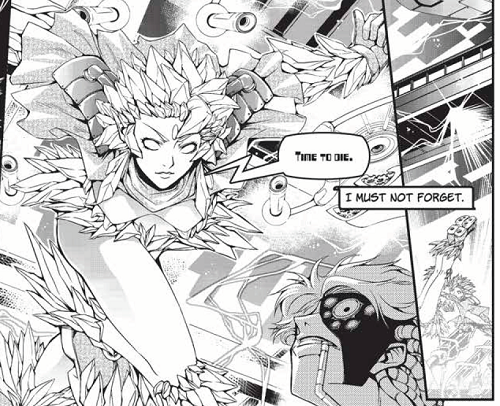 The Exaltation process changes the materials used in Alchemical construction into something greater. As obviously inorganic as they are, they count as living beings for any effects that make that distinction, and upon completion their bodies change further to match their identity (including sexual characteristics, which is why that technician from the last chapter didnít know what sex that Alchemical would turn out to be). If they die, though, they break back down into their component materials, which if collected are worth Resources 5. Alchemicals bleed oil and store their Essence in liquid form at the heart of their body. They donít need to breathe, which means they canít drown or inhale airborne poisons, and ordinary disease canít affect them (supernatural diseases can). They need to sleep as much as anybody else and though they donít strictly speaking need food or water, starvation or dehydration will seriously impact their performance; they normally heal like Solars, but as they starve their ability to gain Essence back and heal drops until they lose the ability to do either of those until they get something in them. They can go way longer than humans without sustenance, though. If they need to heal or get essence quickly, they can go for a dunk in the vats and get a repair and recharge. They also use the vats to spend experience on anything except Abilities, Willpower, and Virtues; they need to spend weeks getting refitted by Sodality technicians for anything except raising Essence, which requires both meditation and simultaneous extensive refits. At Essence 6, Alchemicals turn into giant robots at least 15 feet tall; they call these Colossi, and an Alchemical needs at least 100 years of experience just to survive the process. They undergo a similar transformation at Essence 7, becoming even bigger in exchange for surviving even longer. After about 500 years, a Colossus can increase their Essence further by mustering a bunch of followers, following signals from Kadmek until they hit a likely spot, and turning into a nascent city; they sink a bunch of drills and sensors into the nearby metal, dissolve their bodies into a concentrated core (from then on the CPU of the city) and after the obligatory symbolic eight months they unfold into a metropolis or patropolis. Though this technically isnít the correct terminology, Iíve stuck to calling these cities instead of either of those terms to 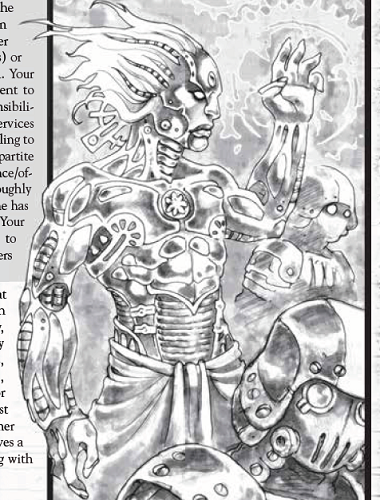 If you are familiar with Exalted Backgrounds, you already know how Allies, Contacts, and Mentors work for Alchemicals (though Adamants get a free Mentor of at least three dots to represent their divine patron). Artifacts work similarly, but in Autochthonia theyíre cheaper, more powerful, and technically state property (though between social pressure and propaganda benefits theyíll never force them to give them back). Backing only barely exists, given how rare independent organizations are in Autochthonia, and Cults rarely form between official prohibitions and Autochthonian religion focusing on the Great Maker. As the situation gets more desperate that last one might shift, though. You can have a Familiar, but given Autochthonia, they have to be a spirit of some kind and they almost certainly were assigned to you by the Divine Ministers in exchange for service. Manses donít exist (they donít have equivalents in Autochthonia unless it breaches Creation), and if you take Command works like it does in Creation with elite soldiers, even though they treat it as a new Background Speaking of which, this book comes with a whole grip of new Backgrounds. Unless they are Adamants dealing with outcast colonies Followers, Influence, and Resources arenít available to PCs; they all get folded into a new background called Class. Class covers a personís position in Autochthoniaís social hierarchy and given how the state assigns subordinates, changes a personís power depending on their pull in the class system, and gives people stuff depending on their ranking instead of their property or income, none of them apply directly. For all that Autochthonian life is rigid and exhausting, they are actually pretty good at providing for their people; those with Class 1 or 2 have a standard of living that equates to someone in Creation with a dot beyond that in Resources, and even the Lumpen get a dole worth Resources 1. They have to live in crowded dorms, though. Alchemicals get Class 3 for free, and with it they get their own teeny apartments, the right to requisition anything worth up to Resources 4 with Tripartite approval, and a small staff (humans get the same but have to share apartments). Both Alchemicals and humans at the next level get a townhouse to themselves as well as more access to resources and a bigger staff, while someone with Class 5 can live sumptuously and get their hands on almost anything. You can also use Background points on Charms (gives you more charm slots), Eidolon (lets you use memories from past lives to stave off Clarity), and Savant (you have some deep connection with Autochthon that gives you bonuses to rolls in a certain field, only accessible to Alchemicals, Sodalities, and I think ex-Drones) And only now do we reach castes. Each caste has an Anima effect that gives them bonuses and flashing lights whenever they spend Essence, favored Attributes, and a whole mess of fluff. 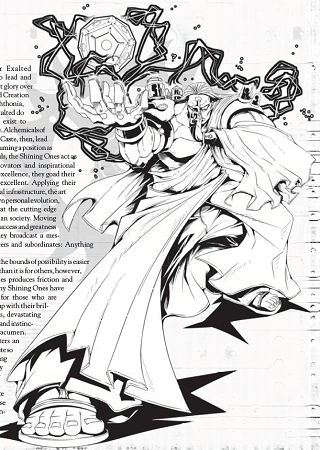 Solars were designed to rule over and command humans in Creation, but their Orichalcum equivalents in Autochthonia are more ďlead by exampleĒ types. The previous lives of Orichalcums generally include not just leaders or heroes, but people who did something big and new successfully: think reformers and and famous inventors of various stripes. More ordinary great leaders donít hurt, though. Given how Autochthonian society works, that usually means their past selves were Tripartite members, leaving them detached from the Populat and self-absorbed. And oh man are they full of themselves; they have a habit of trying to take over anything they get involved with and try to lead their assemblies whether their fellow Alchemicals like it or not (or whether they can handle it or not). Their background means they tend to go heavy into technological development as they get older, culminating in cities that are as much research labs as urban areas. Orichalcums tend to look like a mad scientist had a one night stand with the concept of gaslight fantasy; lots of brass, glass over bubbling liquids and gears, and lightning sparking out every time they use their powers. By spending Essence they can weaponize that lightning and add some damage to their attacks, too. Being robo-Gryffindors, they favor Strength, Charisma, and Intelligence, anything that lets them accomplish great feats. 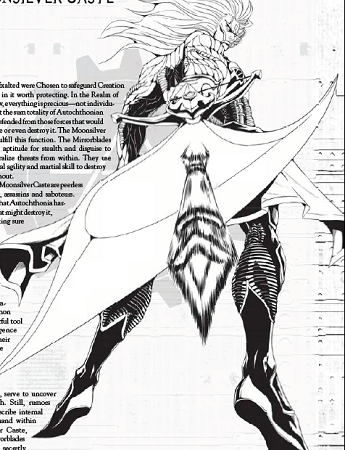 Moonsilvers are the local equivalent of Lunars with a heavy emphasis on stealth and information gathering. Moonsilvers needs souls who were innovative in a different way from those of Orichalcums; the sort of people who come up with crazy ideas that just might work. They tend to combine a trend towards introspection with their speed of thought to become specialists in roles ranging from frontline fighters to spies, though they often find ways to apply their skills in that field in different but analogous situations; they tend to shun leadership roles. As they get more powerful, Moonsilvers either start deploying information-gathering drones or become a bizarre cross between undetectable assassin and killer robot, eventually unfolding into cities that strike the balance between constantly watching everyone and being nice about it. They tend to look more organic and smoother than most Alchemicals, ranging from looking like Noi in the picture I posted in Chapter 2 to something on the more benign side of H. R. Giger, and when they spend enough power they basically cast Haste on themselves. As they lean towards adapting quickly to any situation, they favor Dexterity, Appearance, and Wits. They are cross between Slytherins, sneaksmen, specialists, and the devsí inability to pin them down to a coherent concept. Others will probably disagree, though. 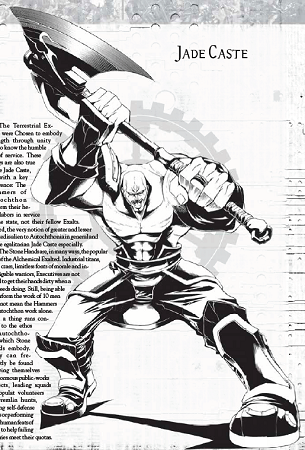 While Jades formed the basis for Terrestrial Exalted, they have a significantly more egalitarian outlook. They come from souls that at various points put others ahead of themselves to their own detriment, whatever the stakes; someone who saves their patient at the cost of their life is as suitable as the guy who always takes on everyoneís shifts when they get sick. Jades are idealized members of the Populat; humble, cooperative, personable, and highly skilled, they tend to spend their offtime working with ordinary people to make their lives better and usually resist Clarity because of the connections they form, though they can be the rare Alchemical who gets too attached; sometimes, you have to make a sacrifice for the greater good, and Jades suck at that. They tend to be tanks in combat and the emotional heart of their assemblies out of it, and they continue supporting others as they grow; Jade Colossi often become a mix between moving fortifications and construction equipment, while the urban layout and infrastructure former Jades produce usually get copied in part or wholesale by other cities later on. They usually look like a person-shaped chunks of jade wearing relatively little clothing; when they expend their power the air around them takes on their coloration in geometric patterns and their resistance to damage climbs in proportion. Being the kind of people who mix leadership with toughing things out, and also because they are Hufflepuffs except cooler, they favor Stamina, Charisma, and Wits. 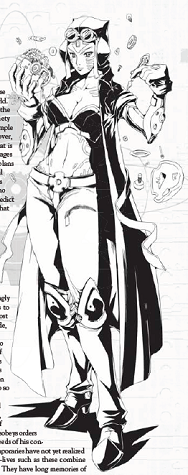 Starmetals, like their Sidereal cousins, like to work behind the scenes. These guys make and carry out plans, collate information, and manage spy networks. In previous lives they were innovators who, unlike Orichalcum leaders or Moonsilver last-chancers, broke new ground of their own volition, with or without prior authorization. Think the soldier who takes command on sheer force of personality and wins despite ignoring the chain of command, or a religious leader that realizes their followers are about to fall into heresy Ė not already fallen, not vulnerable to, but early enough in the process to both keep their congregation together and uncover the reasons behind their fall. As Alchemicals, they tend to trust their judgments over those of others (sounds like Sidereals), act on their assumptions before anyone else can point out their flaws (still sounds like Sidereals), and end up watching in dismay whenever their actions backfire and send their plans slamming into each other like a line of people in an old cartoon when the one in the front stops (definitely sounds like Sidereals). Still, their plans usually work, and in assemblies they excel in behind-the-scenes support of various kinds ranging from mission control to political dealmakers. In spite of their general sneakiness, they hold a lot of cachet with the Autochthonian public Ė not just because, you know, they handle their own spin, but because they cultivate an image of being the sneakiest bastards on YOUR side; itís hard to be afraid of a troll if they spend their time punking people you donít like. Think a mixture of trickster figure, movie hacker, and guardian angel. Of course, Starmetals are Autochthonians, so they focus their plotting on maximizing efficiency by information control; they very rarely lie directly, since if people donít trust your word itís harder to get them to follow your plans when they next come up, and that would reduce the effort-to-effectiveness ratio. Starmetals tend to go for a mixture of minimalism and delicacy in their appearance; lots of thin wire and filigree around basic shapes. Their animas are blue and shot through with static, and when they spend enough power they gain an huge bonus to attack and damage roles accompanied by a sort of before-image that shows you what theyíre about to do a little too late for you to do anything about it. As Ravenclaws with an eye towards playing people, they favor Dexterity, Manipulation, and Intelligence. I love these guys so much. If I had the chance to play one Iíd take it in a heartbeat. 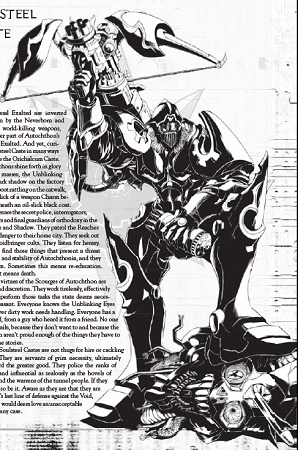 Abyssals donít exist in Autochthonia, but you need a caste for everybody, so Soulsteels step in to fit the bill. A body made of soulsteel needs a soul with a history of producing hardliners and diehards, regardless of whether their actions were justified or not; think someone who blows up his house to keep a fire from spreading or someone who sparks an international war because the other side isnít religiously observant enough. Apparently, the body will just eat the soulgem otherwise. I tried to think of a way to describe them that doesnít boil down to ďthey are BatmanĒ and if it wasnít for the fact that they often kill their enemies, I wouldíve failed. They hunt down evildoers in secret, dispose of them, and move on, sparing no criminal, no matter their power or status. They even avoid falling in love because 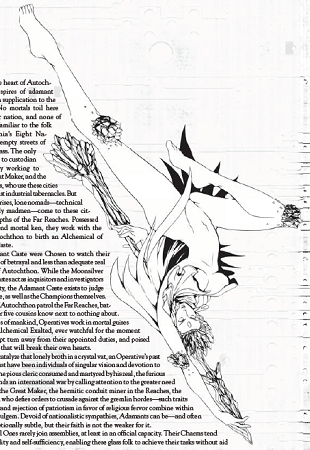 Adamants are not just unique in that they have no Creation equivalent, but in that they exist apart from Autochthonian society. They dedicate their lives to direct service of the Divine Ministers and Autochthon; though they can and do join assemblies informally, they tend to spend time with them only when they are in the field (during which they serve as heavy hitters) until their loneliness gets the better of them. Their soulgems draw upon people who werenít particularly patriotic but fell just short of religious fanatics, whether they were hermits or major leaders. Not anyone who went so overboard they ended up destroying more than they built, though. They spend their careers hunting gremlins, solving problems, and acting as sort of nonpartisan monitors on human society, and as they grow older they tend to either start leading the Ministersí armies or act as informal governors of human outcast groups. They tried to avoid the city stage, but when they do finally settle down they turn into big, empty cathedrals that mostly house the vats where rogue Sodalts make more Adamants. They look like riotously beautiful crystal formations and their animas refract light appropriately; they remain secret because their anima effect screws with the memory of everyone present who canít spend enough Willpower to punch through it. As mixtures of special agents and expensivex jewelry, they favor Strength, Appearance, and Perception. Man, these guys seem like a headache waiting to happen for GMs who have to work them in to a party. And now, Clarity and Mutations. Alchemicals donít suffer from the Great Curse; instead, as they grow more powerful, the machine side of their personality overwhelms them. They donít lose sight of their morality, per se, but they do grow really impersonal about it; they perform actions because they have logically reasoned they will lead to a favorable outcome rather than having any emotion behind it. You gain a point of Clarity you canít dump every time you raise your Essence and while having certain Charms active, while you gain temporary ones for avoiding people and suppressing Virtues; you can lose those temporary points by spending time with people, uninstalling those Charms, and channeling Virtues. As your Clarity climbs, you start taking social penalties and losing the ability to hold Intimacies with increasingly narrow groups. In return, you get equivalent bonuses to dealing with Autochthonian spirits and performing certain mental tasks, and you also get to have more Essence. 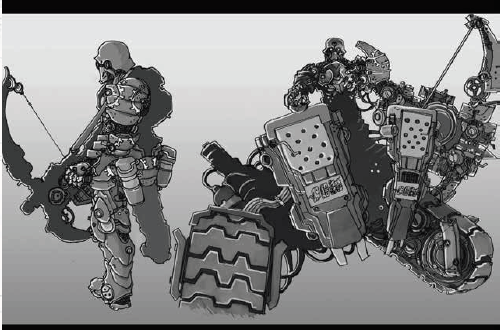 Most Mutations present in Creation also show up in Autochthonia (even if they come from different sources), but the book gives us two new ones. You need the first to build a functional Alchemical; once in a while, a worthy member of the Sodalities will find themselves with the ability to channel part of the Exaltation process. As important as their skills are to putting them together, the technicians who perform the process are as much channeling aspects of Autochthon as part of a ritual as they are physically building the Alchemical. Since they donít actually know how the process works, you canít learn how to make Alchemicals by learning from them; itís why the Sodalt in the intro comic wasnít able to tell the Apostate anything. This mutation also only shows up in Autochthonian humans, no Exalted of any kind, which would complicate any attempts for non-Alchemical PCs to build their own robot friends Finally, we get to see the mechanics for Gremlin Syndrome. Itís a mutation that essentially inverts Clarity; it replaces it with a trait called Dissonance that uses similar mechanics. However, instead of becoming coldly logical and gaining bonuses to interaction with Autochthonian spirits, those with rising Dissonance become impulsively violent, cruel, and prone to randomly destroying machinery and gain bonuses to socializing with gremlins instead. It rises and falls in the same ways. There is no known way to convert Dissonance back to Clarity except euthanasia; even if they want to stay sane, the best an Alchemical with Gremlin Syndrome can do is keep it at bay. Unless, of course, the Solars hit them with enough magical bullshit, because Solars. While I intended to build Rhythm as we went along, Iím finding it a bit taxing to run through character creation in a thoughtful manner while still reviewing the book. Iíll throw the process up in a separate update at the end. Instead, Iíll be devoting next time to forcing my way through the truly colossal Charms list. E: man, itís only after looking back at this chapter that I realize what a grabbag it is. Every chapter in this book reads like the writers came up with some amazing ideas and free-associated until they had an internal structure. There is a clear logic to it, but it sure ainít conventional. Falconier111 fucked around with this message at 06:42 on May 28, 2020 |
|
|
|
GimpInBlack posted:Yggdrasil *Stares at linguistic degree and then out into the cold, dark rain, a single tear falling down his cheek* Also finally caught up with the thread : holy poo poo-balls, Night, you really knocked it out of the park there are the end. I'm (not really) ashamed to admit that I started getting emotionally invested in your character in WHFRP which is new and different. I almost fist-pumped when Gilbert and Ulrike got married. Not only did you write an informative and entertaining little LP thingy, but you made me care about the characters. drat good job. Well done.
|
|
|
|
Xiahou Dun posted:*Stares at linguistic degree and then out into the cold, dark rain, a single tear falling down his cheek* I'm glad you enjoyed it! I actually really liked writing about those characters and they'll be showing up as part of the general stock of WHFRP Setting NPCs my group has accumulated over the years for games set awhile after the Storm. And people like Vendrick show up in the 2600s games and stuff. In general I had a lot of fun with a theme that emerged where none of them really got their perfect ending or exactly what they set out looking for in the beginning, but...it worked out well enough. Karl and Anya were happy enough and did good things. Karl figured out what he was really looking for in the meaning of mercy (especially with what happened with Althura), Anya was happy and comfortable continuing to reach into dark places. Gilbert didn't get the heroic story and Grail he expected as a young man, but he met his wife-to-be and learned a lot about being a more responsible man. Ulrike found the heart of her faith. Vendrick did something genuinely heroic in rejecting his orders and his friends never even knew. Elena accidentally founded the Warhammer Belmonts, which wasn't really the ease and wealth she was after but sometimes Fantasy Athena Jesus hands you a magic vampire killing whip and you have a duty to make it cool as hell. And the poor Warlock they met got put on a better path even if she still makes dumbass Warlock moves and accidentally timecubed herself into the future because I thought she'd be a perfect NPC for another game that happens then. It was fun.
|
|
|
|
Uh if you wanted to say, run some WHFRP over discord I know a server and at least one incredibly enthusiastic potential player.
|
|
|
|
Chapter 7: Battle, pt. 5 Degenesis Rebirth Katharsys Chapter 7: Battle  VEHICLES IN COMBAT VEHICLES IN COMBAT  The only rules section that's always invariably even better than grappling is vehicle rules  The introduction states how basically nobody in Europe can afford to run cars Ė everyone rides horses. The next sentence goes on about how Africans are all cars, all the time, because looting Europe would be impractical otherwise. The question of getting enough gas up to, say, Pollen, is ignored. Anyways, we're told that vehicles - this includes the Mark I Horse - offer great advantages and are well worth it! Speed Vehicle speed is measured via a speed level between 1 and 6. Yet there's also a table which converts that rate to meters per combat round (5 at 0, 10 at 1 and up to 100 at 6). And yes, we're introduced to speed level 0 despite the first paragraph telling us that it goes between 1 and 6. Accelerating and slowing down A mount can accelerate 1 level per round and decelerate 2 per round, though specially trained ones can do better. Vehicles can do better at both depending on the engine. We're also told that speed level 0 is walk for mounts and ďmaneuvering speedĒ for vehicles. Maybe one day, we'll get an errata that will establish Speed -1 as "stationary." A mount gets Flesh Wounds and Trauma just like a person does. They panic as soon as they take Trauma and you have to reign them in with an AGI+Navigation vs. Trauma level roll. Mount & Blade horses these ain't. Metal and mechanics quote:A mountís flesh and blood are a vehicleís fairing, mechanics, and engine. quote:Once the body has been shot down and torn apart, the next hit destroys the steering, tears the brake conduit, or smashes a cylinder piston. Every maneuver AGI+Navigation) must now even out the mechanical damage; the Difficulty rises by the amount of damage points. I swear, they should not let you reprint/release 2E of your RPG if you don't have a technical writer on your team. Armor Car and horse can have armor. Car and horse armor act like person armor. Attacking If you want to attack as a rider/driver, you get to make a combined AGI+navigation and attack Skill roll vs. regular attack number + speed penalty. However, if you're riding shotgun (the book calls it ďco-driverĒ - what kind of Pacific Rim BS is this?), you only get the speed penalty. To the great joy of Mount & Blade players, melee attack damage is increased due to speed. Drive me closer, I want to hit them with my Splayer!  Counterattack: In the Crosshairs Unless the car/mount is moving directly at/away from you, you get a speed penalty to hit them. If they are going straight towards/away from you, that penalty is just +1. Counterattack: Close Combat quote:If you are attacked from horseback or from a vehicle, you can defend actively and even counter. But it becomes harder in conflict: the defenderís Difficulty is raised by the attackers speed when defending actively. If the counter succeeds, the defender gets a damage bonus based on the speed Ramming If you go into RAMMING SPEED, you need to roll AGI+Navigation vs. speed level while the enemy rolls AGI+Dodge vs. speed. If you hit, your car/mount gets speed level in damage, while the target takes 5 times as much. quote:When attacker and target have roughly the same bulk, this looks totally different: then, both take 5 times the damage. Just gently caress off with this writing.  If two moving objects (probably meaning cars and mounts) collide, they take the difference in speeds x 5 in damage. ...does this mean that if two Koms at speed level 6 collide head on, nobody receives damage? Maneuvers ďFancy stuns are hard to write rules for, and cars often move too fast for paper maps, so do theater of mind. Rules? It's all up to the GM!Ē Next time: dumb ways to die
|
|
|
|
"In the land where everyone's a weird fungus horsefucker, the guy with a platoon of technicals is king." - Abraham Lincoln, probably
|
|
|
|
|
Xiahou Dun posted:*Stares at linguistic degree and then out into the cold, dark rain, a single tear falling down his cheek* The unspoken subtext of that bit was "and if I try I'll get it wrong and Xiahou Dun will yell at me." Plus I just wanted an excuse to link to the Old Norse cowboy man, whose channel is just really delightful and informative. Xiahou Dun posted:Uh if you wanted to say, run some WHFRP over discord I know a server and at least one incredibly enthusiastic potential player. Make that two.
|
|
|
|
GimpInBlack posted:The unspoken subtext of that bit was "and if I try I'll get it wrong and Xiahou Dun will yell at me." Plus I just wanted an excuse to link to the Old Norse cowboy man, whose channel is just really delightful and informative. I was just funning. And it's a good informative video. He obviously make some pretty coarse analogies, but I'd do the same given the brief format. It's hard to summarize a whole phonology in 12 minutes without using scary technical words. (One day I will do my passion project of a giant language learning document for linguists where they just use the real words instead of saying it's the vowel of "father" and just say it's /a/. One day. ) Also, as a pretty drat straight man, he's one smoking hot cowboy. Would. PS pretty please Night come to my discord and run WHFRP. I'll make themed sausage recipes just for the occasion.
|
|
|
|
GimpInBlack posted:The unspoken subtext of that bit was "and if I try I'll get it wrong and Xiahou Dun will yell at me." Plus I just wanted an excuse to link to the Old Norse cowboy man, whose channel is just really delightful and informative. I'd totally be up for that as well. Night10194 posted:I'm glad you enjoyed it! I actually really liked writing about those characters and they'll be showing up as part of the general stock of WHFRP Setting NPCs my group has accumulated over the years for games set awhile after the Storm. And people like Vendrick show up in the 2600s games and stuff. An exchange in the latest Heirs of Alexandria book, All the Plagues of Hell put me in the mind of Karl. High Priest: Explains how a certain character has tremendous magical power and is considered a "Bastion of Light." Knight: "I thought he was just a nice young man." High Priest: "He is. It's possible to be both." It's hilarious to me how well the party with Karl et al did just by being nice, decent, considerate people who didn't gently caress over all and sundry for a few extra gold pieces. BTW, the Heirs of Alexandria series is pretty cool. It's like somebody decided to port their WHFRPG campaign into real world Europe circa 1530 in a good way.
|
|
|
|
Yggdrasil Part Five: A "Pining for the Fjords" Joke Would Be Too Obvious Norway gets the least page space of all the kingdoms, probably because there's not nearly as much historical or even pseudo-historical source material to draw on. Historically, Norway was completely disunited until Harald Fairhair came along in the late 9th century--and even he's sketchy enough that he might well be completely fictional. Norway, at this point in history, is a geographical term, not a nation or a state. Yggdrasil does say that even more than the other kingdoms, Norway is a mosaic of independent clans and minor sovereignties, so it's not like they're spinning a strong central government out of thin air, but still, this section is a little thin. Norway encompasses all the lands on the seaward side of Midgard (or at least the Scandinavian peninsula). The straits of Skaggerak and the Kattegat separate Norway from Denmark, and are positively lousy with pirates. Lots of those pirates are the inhabitants of fishing villages on the many, many islands that dot Norway's coast and are more than happy to put down their nets and pick up spears if a fat merchant knŲrr sails too close. These islands are usually somewhat warmer than you might expect from their latitude, but the weather is treacherous and can change very rapidly. Like the islands of Denmark, lots of these islands and archipelagos are ruled by independent-minded jarls and petty kings, mainly supported by hunting, fishing, and whaling, since the soil isn't great for agriculture. Unlike the Danish islands, the deepwater channels off the Norwegian coast means these islands are menaced by krakens and, perhaps most famously, the maelstrom. This enormous ship-eating whirlpool is said to lie in the Loftofen archipelago, and legends say that ships sucked into its maw are flung into one of the other Nine Realms. On the mainland, the terrain is rugged and harsh--everybody knows about Norway's fjords, and lots of settlements are located at their mouths, but still, Norway is sparsely populated and much of the coastline is uninhabited and even unexplored. The coasts are also the only place where any significant agriculture can be performed, and even then Norwegians rely more on hunting, trapping, and fishing than farming. The further inland you go, the more rugged and harsh the land becomes until you hit the mountains. The uplands are often impassable, with thick mazelike forests and high, forbidding mountains with treacherous passes. The tribes who live here are longtime enemies of the Norse, and don't hesitate to attack travelers. There are a few mining settlements in the mountains, but on top of the hostile tribes, bandits love to raid mining towns and carry off their produce. Norway also has more sacred places than much of Scandia: sacred groves, waterfalls, standing stones, and so on are all over the place. Much like Sweden, the northern parts of Norway have no real seasons, just an endless, cold day in the summer and the endless, cold night of winter. The Halogi are the only Norse tribe to live this far north, and though they speak Old Norse and worship the Aesir and Vanir, they are fiercely independent and are considered formidable warriors--rumors say they have jotunn blood in their veins. They're often recruited as mercenaries by Norse kings and jarls. Norway has few large towns or trading posts; the king reigns from Fort Njord in the Oslofjord, dominating the small city of Oslo (obviously modern-day Oslo, though the real Oslo wasn't founded until around AD 1000), and Maere and Klepp are fishing towns facing the great Western Ocean, built at the mouths of fjords (Klepp and Maere are both real towns in Norway and probably old enough to have existed in Yggdrasil's timeline, but neither's geography really matches what's described here: Maere is deep in the Trondheimfjord and can hardly be said to "face the Western Ocean," and Klepp is on the west coast but not in a fjord). Borre, on the Skaggerak, is Norway's only major merchant town, a cosmopolitan place of 2,000 people that swells to 6,000 during the twice-yearly fairs at the spring equinox and summer solstice. (Again, no real mystery here, Borre is the modern name of the still-extant town, the Old Norse form would have been Borrů). Norway doesn't even get a section on Country Organization, which shows you just how fragmented Norway is. The royal house (which doesn't get a name, but is called out as claiming descent from Thor) has been trying to forge ties between the independent jarls and petty kings through political marriages, but it's slow going. Also, this book really wants us to know about the "savage tribes" that live in the mountains and hate the Norse, because they get what I think is a fourth callout here. No additional information, no nuance or expansion, just yet another reminder that there are tribes, they are savage, and they hate the Norse. That's all. Personally I choose to interpret these as hillbilly Viking cannibals, but that's just me. Only two characters get called out here: Hring, the King of Norway, is a giant of a man with gigantic appetites and a mercurial personality, but he's no mindless berserk--he took the throne as a young man after his father's death in battle against a rebellious jarl, but rather than pursuing a blood feud, he accepted wergild for his father, married his rival's daughter, and made peace. He loves fighting, but recognizes that he can't unify Norway through conquest, so he's continuing his grandfather's plan of "push strategic marriages and build trade networks." That's about it--the only real hook with him is that he's unmarried and looking for a wife. On the other hand, Starkad the Skald is a pretty neat character--he's a dreamy heartbreaker, basically a Norse rock star, but he's morose and brooding (which naturally only makes him sexier); see, he's half-jotunn, and Thor hates him. He was born, or so the story goes, with six arms, but Thor ripped four of them off. Odin adopted him, though, and decreed that he would live "three lives of men." Thor countered by decreeing that during each of those lives he would commit an act of the worst cowardice. Odin gave him the best weapons, but Thor cursed him to never hold land. Odin granted him victory in every battle, but Thor decreed he would always be wounded. Odin made him a great skald, but Thor cursed him to forget every song once he's sung it. His life is a living hell. There's not much in the way of hooks for using him, but he's a cool character and I could easily see a more mythic game trying to convince Thor to lay off the poor guy. As near as I can tell Hring is a purely fictional character--the closest I can find is Sigurdr Hring, but he was a King of Denmark and supposedly the father of Ragnar Lothbrok, so he's almost 500 years too late for this period. Starkad is a mythological character, appearing in a few sources, including our old pal Beowulf, but the story where he's an eight-armed (not six) jotunn foster son of Odin, blessed by the Allfather and cursed by Thor comes from Gautreks saga. In that source, Thor also curses him to be hated by common folk, which would seem to be at odds with his dreamy rock star persona here, and the "Thor ripped his extra arms off" bit appears to be an Yggdrasil addition. He's most famous for his part in the sacrifice of the reluctant King VŪkar of Agder: on an expedition, VŪkar was becalmed, and the seers said that Odin required a human sacrifice chosen by lots. VŪkar's lot kept coming up, but he didn't want to die, so he kept putting it off until Odin came to Starkad and said "look, you need to murk this fool for me." Starkad agreed, and so the next day he goes to VŪkar and says "look, how about we just pretend to sacrifice you? We'll 'hang' you with some calf intestines and I'll throw a reed at you like a spear, and we'll call it good." So the king agrees, and they do the fake sacrifice--but as soon as they pull the gut-noose tight it becomes a real rope, and when Starkad throws the reed it turns into a real spear, and VŪkar dies. Yeah, don't try to con Odin, he's better at it than you. So, that's the three principle kingdoms of the Norsemen. Overall I really like the setting writeup. It focuses on the stuff that's important and useful to a campaign, and generally has a lot of actionable story hooks sprinkled throughout. Norway is definitely the weakest of the three, and I think that's because of the aforementioned lack of historical research, but also because its only real distinguishing feature is "weak king and lots of independent chieftains struggling for power," which is... also a feature of Denmark and Svithjod, on top of the recent civil war, family tensions, and sinister warlock-kings. It's just kind of bland. Next Time: Finland, Finland, Finland! The country where I want to be pony trekking, or camping, or just watching TV!
|
|
|
|
Xiahou Dun posted:Uh if you wanted to say, run some WHFRP over discord I know a server and at least one incredibly enthusiastic potential player. I can't promise anything because I actually struggle more with group games than it sounds like (I actually run a lot of single PC games because it's a format I surprisingly find a lot more comfortable to write on the fly, while group stuff takes more prep, so I often only run one group game at a time at once) but I'd be happy to at least drop by and chat sometimes if you give me the server.
|
|
|
|
Xiahou Dun posted:Uh if you wanted to say, run some WHFRP over discord I know a server and at least one incredibly enthusiastic potential player. Same
|
|
|
|
Xiahou Dun posted:Uh if you wanted to say, run some WHFRP over discord I know a server and at least one incredibly enthusiastic potential player. Probably like the tenth person to say this, but same.
|
|
|
|

|
| # ? Apr 18, 2024 04:41 |
|
GimpInBlack posted:As near as I can tell Hring is a purely fictional character--the closest I can find is Sigurdr Hring, but he was a King of Denmark and supposedly the father of Ragnar Lothbrok, so he's almost 500 years too late for this period. It's Hring, son of Raum the Old. Hring was purportedly the king of Ringerike, a central location in Norway. His claim to the title King of Norway comes from being the grandson of Nůr, the mythical first king of Norway (as opposed to Harald HŚrfagre, the other maybe mythical first king of Norway) and ancestor of all Norwegians. Nůr was son of Thorri, but it's unclear/ambiguous if Thorri and Thor are actually the same figure.
|
|
|

















